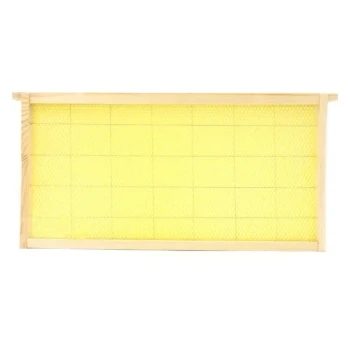Historically, wooden hives were preferred because they most closely replicate the natural nesting environment of honeybees. This alignment with a bee colony's instincts, combined with wood's availability and workability, made it the default choice for beekeepers for centuries.
The preference for wood wasn't just about tradition; it was a practical decision rooted in bee biology. A wooden hive offers a breathable, textured, and familiar environment that helps a colony regulate its own temperature and humidity, much like it would in a hollow tree.

Aligning with the Bee's Natural Instincts
The most successful beekeeping practices work with the bees' innate behaviors, not against them. Wood's properties make it an ideal partner in this endeavor.
The Hollow Tree Analogy
Bees in the wild seek out cavities in trees to build their nests. A wooden hive is the closest artificial approximation of this natural home.
The familiar texture, scent, and even the subtle way wood absorbs and releases moisture create an environment that a colony can readily accept and thrive in.
Breathability and Moisture Control
A bee colony generates a significant amount of heat and water vapor. Wood is porous and "breathes," allowing some of this moisture to escape the hive naturally.
This characteristic helps prevent the buildup of excess condensation, which can be detrimental to the colony's health, especially during cold winter months.
Practical Advantages for the Beekeeper
Beyond the benefits for the bees, wood offered significant practical advantages that cemented its role as the traditional hive material.
A Natural and Sustainable Resource
Wood is a renewable resource, a key consideration for many environmentally-conscious beekeepers. When sourced responsibly, it has a low environmental footprint compared to synthetic alternatives.
Furthermore, at the end of its life, an untreated wooden hive is fully biodegradable and can be disposed of safely.
Understanding the Trade-offs
While traditionally preferred, wood is not without its challenges. Understanding its limitations is key to using it effectively.
The Need for Maintenance
Wood is susceptible to the elements. Without protection, it will rot, warp, and degrade over time.
To ensure longevity, wooden hives must be treated with paint, oil, or wax. This requires an ongoing commitment to maintenance from the beekeeper.
Weight and Durability
Wooden hives, particularly when full of honey and bees, are heavy. Their weight can be a significant factor for beekeepers who need to move their hives frequently.
They are also more prone to damage from pests like termites or decay from fungi if not properly cared for.
Making the Right Choice for Your Goal
The choice of hive material today depends on your specific beekeeping philosophy and priorities.
- If your primary focus is traditional, natural beekeeping: Wood remains the undisputed choice for its alignment with bee biology and its sustainable properties.
- If your primary focus is low maintenance and longevity: Modern materials like high-density polystyrene or plastic may be a better fit, though they lack wood's natural breathability.
- If your primary focus is insulation in extreme climates: Polystyrene hives offer superior thermal regulation, potentially reducing stress on the colony during harsh winters or hot summers.
Ultimately, understanding why wood was the traditional standard empowers you to make an informed choice that best suits your bees and your goals.
Summary Table:
| Aspect | Why Wood Was Preferred |
|---|---|
| Bee Biology | Closely mimics a natural hollow tree, providing a familiar, breathable environment. |
| Moisture Control | Porous nature helps regulate humidity and prevent condensation buildup. |
| Sustainability | A renewable, biodegradable resource with a low environmental footprint. |
| Practicality | Readily available and easy for beekeepers to work with and modify. |
Ready to choose the right hive for your apiary? At HONESTBEE, we supply commercial beekeepers and equipment distributors with high-quality, traditional wooden hives and a full range of beekeeping supplies. Our wholesale-focused operations ensure you get durable, bee-friendly equipment that supports colony health and your bottom line. Contact HONESTBEE today to discuss your needs and place your order!
Visual Guide

Related Products
- Langstroth Bee Hives Bee Keeping Box for Beginners Beekeeping
- Wholesales Dadant Size Wooden Bee Hives for Beekeeping
- HONESTBEE Professional Long Handled Hive Tool with Precision Cutting Blade
- Long Langstroth Style Horizontal Top Bar Hive for Wholesale
- Professional Drop-Style Hive Handles for Beekeeping
People Also Ask
- How does the ease of access differ between 8-frame and 10-frame hives? Choose the Right Hive for Your Body
- What are the key features of the Langstroth beehive? A Guide to the Standard for Modern Beekeeping
- Should a beginner try a different type of hive? Start with a Langstroth for a solid foundation.
- What is the best type of bee hive for beginners? Start with the Proven Langstroth Standard
- What basic equipment is needed to start beekeeping? Your Essential Guide to a Confident Start



















